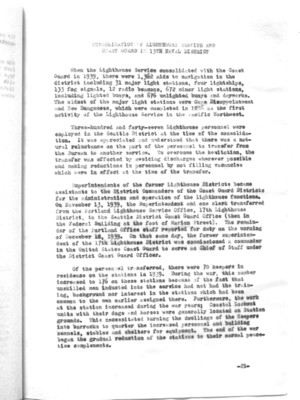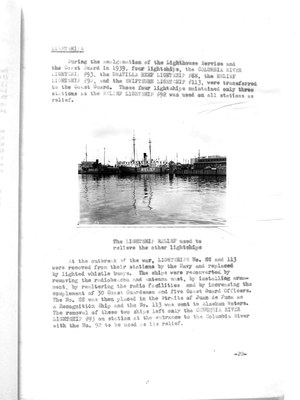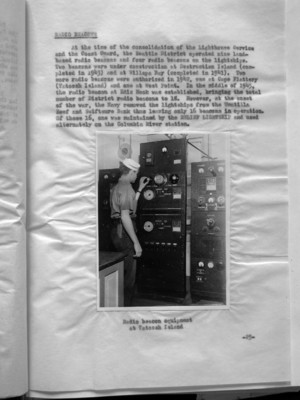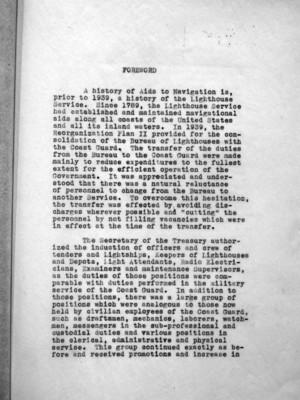Pages That Mention lightships
Coast Guard District narrative histories 1945
4
CONSOLIDATION OF LIGHTHOUSE SERVICE AND COAST GUARD IN 13TH NAVAL DISTRICT
When the Lighthouse Service consolidated with the Coast Guard in 1939, there were 1,362 aids to navigation in the district including 31 major light stations, four lightships, 133 fog signals, 12 radio beacons, 672 minor light stations, including lighted buoys, and 676 unlighted buoys and daymarks. The oldest of the major light stations were Cape Disappointment and New Dungeness, which were completed in 1856 as the first activity of the Lighthouse Service in the Pacific Northwest.
Three-hundred and forty-seven Lighthouse personnel were employed in the Seattle District at the time of the consolidation. It was appreciated and understood that there was a natural reluctance on the part of the personnel to transfer from the Bureau to another service. To overcome the hesitation the transfer was effected by avoiding discharges whenever possible and making reductions in personnel by not filling vacancies which were in effect at the time of the transfer.
Superintendents of the former Lighthouse Districts became assistants to the District Commanders of the Coast Guard Districts for the administration and operation of the lighthouse functions. On November 13, 1939, the Superintendent and one clerk transferred from the Portland Lighthouse Service Office, 17th Lighthouse District, to the Seattle District Coast Guard Office (then in the Federal Building at the foot of Marion Street). The remainder of the Portland Office staff reported for duty on the morning of December 18, 1939. On that same day, the former superintendent of the 17th Lighthouse District was commissioned a commander in the United States Coast Guard to serve as Chief of Staff under the District Coast Guard Officer.
Of the personnel transferred, there were 70 keepers in residence on the stations in 1939. During the war, this number increased to 176 on these stations because of the fact that unskilled men inducted into the service had not had the training, background nor interest in the stations which had been common to the men earlier assigned there. Furthermore, the work at the station increased during the war years; Coastal Lookout units with their dogs and horses were generally located on Station grounds. This necessitated turning the dwellings of the Keepers into barracks to quarter the increased personnel and building kennels, stables and shelters for equipment. The end of the war began the gradual reduction of the stations to their normal peactime complements. -22-
5
During the amalgamation of the Lighthouse Service and the Coast Guard in 1939, four lightships, the COLUMBIA RIVER LIGHTSHIP 393, the UMATILLA REEF LIGHTSHIP #88, the RELIEF LIGHTSHIP #92, and the SWIFTSURE LIGHTSHIP #113, were transferred to the Coast Guard. These four lightships maintained only three stations as the RELIEF LIGHTSHIP #92 was used on all stations as relief.
(Photo of Relief Lightship displayed with caption below)
The LIGHTSHIP RELIEF used to relieve the other lighthships
At the outbreak of the war, LIGHTSHIPS No. 88 and 113 were removed from their stations by the Navy and replaced by lighted whistle buoys. the ships were reconverted by removing the radiobeacon and antenna mast, by installing armament, by realtering the radio facilities and by increasing the complement of 30 Coast Guardmen and five Coast Guard Officers. The No. 88 was then placed in the Straits of Juan de Fuca as a Recognition Ship and the No. 113 was sent to Alaskan Waters. The removal of these two ships left only the COLUMBIA RIVER LIGHTSHIP #93 on station at the entrance to the Columbia River with the No. 92 to be used as its relief.
-22-
8
At the time of the consolidation of the Lighthouse Service and the Coast Guard, the Seattle District operated nine land-based radio beacons and four radio beacons on the lightships. Two beacons were under construction at Destruction Island (completed in 1943) and at Willapa Bay (completed in 1941). Two more radio beacons were authorized in 1942, one at Cape Flattery (Tatoosh Island) and one at West Point. In the middle of 1945, the radio beacon at Ediz Hook was established, bringing the total number of District radio beacons to 18. However, at the onset of the war, the Navy removed the lightships from the Umatilla Reef and Swiftsure Bank thus leaving only 16 beacons in operation. Of these 16, one was maintained by the RELIEF LIGHTSHIP and used alternatively on the Columbia River station.
(Photo inserted here)
Radio beacon equipment at Tatoosh Island
-25-
16
FOREWORD
A history of Aids to Navigation is, prior to 1939, a history of the Lighthouse Service. Since 1789, the Lighthouse Service had established and maintained navigational aids along all coasts of the United States and all its inland waters. In 1939, the Reorganization Plan II provided for the consolidation of the Bureau of Lighthouses with the Coast Guard. The transfer of the duties from the Bureau to the Coast Guard were made mainly to reduce expenditures to the fullest extent for the efficient operation of the Government. It was appreciated and understood that there was a natural reluctance of personnel to change from the Bureau to another Service. To overcome this hesitation, the transfer was effected by avoiding discharges wherever possible and "cutting" the personnel by not filling vacancies which were in effect at the time of the transfer.
The Secretary of the Treasury authorized the induction of officers and crew of tenders and Lightships, Keepers of Lighthouses and Depots, Light Attendants, Radio Electricians, Examiners and Maintenance Supervisors, as the duties of those positions were comparable with duties performed in the military service of the Coast Guard. In addition to those positions, there was a large group of positions which were analogous to those now held by civilian employees of the Coast Guard, such as draftsmen, mechanics, laborers, watchmen, messengers in the sub-professional and custodial duties and various positions in the clerical, administrative and physical service. This group continued exactly as before and received promotions and increase in
19
CONTENTS
I LIGHT STATIONS 1 II LIGHTSHIPS 14 III RADIOBEACONS 18 IV UPPER COLUMBIA RIVER 25 V BLACKOUT 39 VI ANRAC 45 VII SPECIAL BUOYS 51 VIII RACON-LORAN 56 IX LOCAL NOTICES TO MARINERS 68 X BUOY CARD FILE SYSTEM 69 XI TENDERS 75 XII STANDARDIZATION OF MINOR AIDS 80 XIII PERSONNEL OF AIDS TO NAVIGATION SECTION 83 XIV CHAPTER NOTES 1,11




